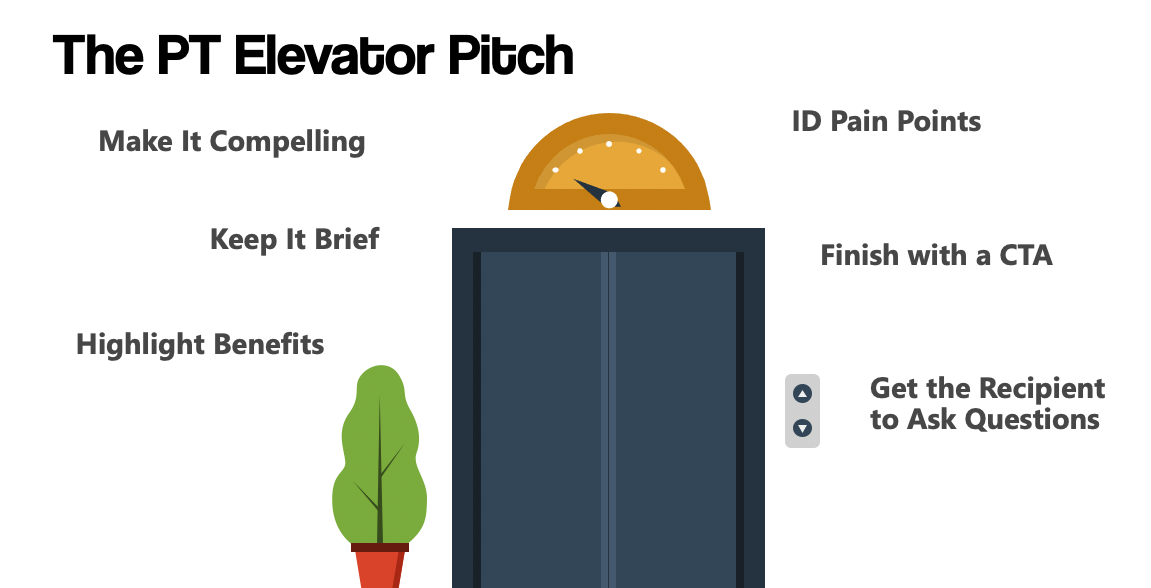What is an elevator pitch? An elevator pitch is defined as a succinct and persuasive sales pitch.
Elevator pitches are also known as a talking logo by John Jantsch of Duct Tape Marketing or Your One Liner by Donald Miller of StoryBrand.com . Each of these marketing experts have their own take on what makes up a quality elevator pitch; however, at the end of the day, there are far more similarities than differences between the three.
Why is an elevator pitch necessary?
Well, let’s say you are at a networking event, an industry event or you happen to bump into someone who requires your service. An elevator pitch is designed to entice people to stop, listen and develop an interest in your service. It’s an excellent way to connect with important contacts and potential clients.
Here are 4 important steps to creating the perfect elevator pitch:
Keep Your Elevator Pitch Brief
You don’t need to deep dive into your extensive work history and experience. An elevator pitch should be a quick recap. Ensuring your audience can quickly grasp who you are, what you do, and most importantly, how you can benefit them. You should keep your elevator pitch to under 60 seconds.
Understand Your Target Audience and Identify their Pain Points
The easiest way to grab someone’s attention is to identify something that they’re struggling with. By demonstrating that you understand the problem, you’re instantly placed in a position of credibility.
Can everyone on your team answer the question, “What do you do?” A great way to answer is to with a question. “Have you ever had any pain in your muscles or joints?”
An orthopedic physical therapy practice most certainly deals with patients that have pain – it’s their number one concern in most cases. Pain is what your patients want to avoid, get rid of, and learn how to prevent from returning.
Highlight the Biggest Benefit of Your Physical Therapy Service
Your elevator pitch should highlight the biggest benefit of your PT service. It may be difficult to limit which benefits you share. However, it’s a good idea to base it on the pain point you’ve identified as well as the features that make your business stand out from the competition.
At this point, I suggest you create some curiosity. After you’ve asked the question above, respond to their “yes” answer with something that creates curiosity. You might say, “So many do, that’s why I learned how to alleviate pain with my hands.”
This should inspire the person you are speaking with to ask the question, “How do you do that?”
The response could be something like this – “As a physical therapist, I’ve learned a number of manual therapy and therapeutic exercise techniques that addresses the underlying cause of pain and helps people avoid unnecessary drugs, expensive tests, & surgery.”
Finish with a Call to Action
Once you’ve completed your pitch, what action do you want them to take next? For example, should they call to book an appointment?
At this point you need to read the person you are speaking with. If they follow up with more questions, ask them this, “Would like to come by for a quick free exam? I might be able to help.”
If they say they know someone with pain, ask them if they are nearby – offer them a free exam.
Don’t leave anyone up to their own devices. Be very clear about what action they should take next to secure your PT services.
Why This Works…
More often than not, PT practice owners are incredibly passionate about their care and the opportunity to help. It’s easy to get caught up in conversation and launch into a long-winded explanation about how wonderful their care is, etc. Though well-intentioned, this often loses the attention of the audience. Even worse, it decreases the chance of them doing business with you.
An elevator pitch keeps your explanation concise and direct. Getting right to the important key points that will motivate them to take action.
What do you get out of all this?
Having an elevator pitch ready to share who you are, what you do, and how you can benefit the potential client is a quick and easy way to get your business on their radar. It tells them what they need to know so they can make an informed decision on your services.
As a result, it allows you to successfully generate more new business and book more clients.
An Elevator Pitch is a Sales Tactic…For PT Marketing, You Also Need These Strategies
An elevator pitch is important and especially useful if everyone in the office is using one to communicate your practice’s value. However, when it comes to online marketing, you want to do these things first:
- Create a great website that tells a compelling story and funnels viewers to your call to action.
- Email marketing to retain your past patients.
- Rank on as well as you can on Google – Google is where almost everyone starts their online search for a physical therapy clinic.
- Have the best reputation in town – trust is the number opportunity for small clinics to differentiate themselves from the big corporations. There’s no better place to show your community that you can be trusted, than with ratings and reviews on Google and your website.
If you would like to learn more about how E-rehab.com can help you get your online marketing right, click here to schedule some time with David Straight, DPT and co-owner of E-rehab.com

